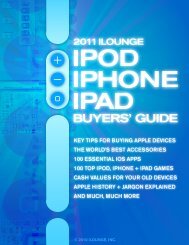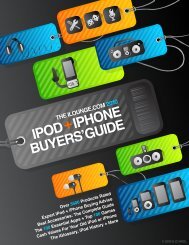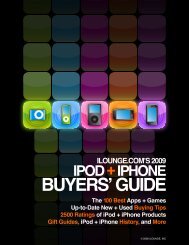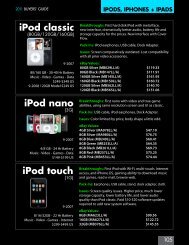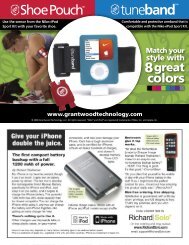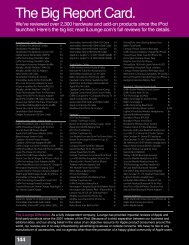Downloading - iLounge
Downloading - iLounge
Downloading - iLounge
You also want an ePaper? Increase the reach of your titles
YUMPU automatically turns print PDFs into web optimized ePapers that Google loves.
The Verizon iPhone 4: Small Antenna Changes Force Case Tweaks<br />
For its first three years in the United States,<br />
the iPhone was exclusive to AT&T - now the<br />
country’s second-largest carrier - which proved<br />
unable to cope properly with ever-increasing<br />
demands on its cellular network. Call drops<br />
became so bad in certain cities that Apple’s<br />
reputation for delivering great products<br />
began to suffer. When the exclusive ended, the<br />
iPhone 4 came to Verizon, AT&T’s bigger and<br />
more reliable rival. Based on all the complaints<br />
about AT&T, many people expected a massive<br />
outflux to Verizon, but that didn’t happen:<br />
Apple merely tweaked last year’s iPhone to<br />
work with Verizon’s old CDMA network, which<br />
has broader coverage inside the U.S. but runs<br />
slower, and has little international support -<br />
hence, there’s no SIM card slot. Apple also<br />
changed the iPhone 4’s antenna-separating<br />
bands, moving the side ringer switch and<br />
volume buttons down a little. Consequently,<br />
Apple and other case makers had to redesign<br />
their cases with a larger side switch hole.<br />
Around the same time, Apple encouraged<br />
developers to cut a huge hole for the rear<br />
camera and flash to avoid exposure problems<br />
caused by the bright LED light and whatever<br />
surrounds it. The next iPhone will likely have<br />
fewer variations, and a relocated LED flash.<br />
141



